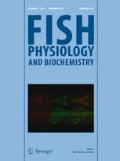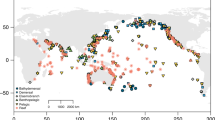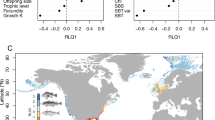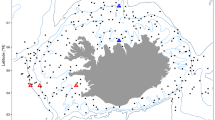Abstract
The latitudinal extension of southern South America imposes a thermal gradient that affects the structure of marine and freshwater fish assemblages and the biology of the species through direct exposure to the temperature gradients or by means of a web of historical and ecological relationships. We have reviewed biological and ecological data of marine and freshwater fishes from the southern Neotropics, including Patagonia, and report several examples of dependence on temperature, from glacial times to today’s climate change. We were able to identify historic and present effects on the diversity of fish assemblages, isolation, southern limits for the distribution of species, and morphological variation among populations. There is a wide range of characteristics that exemplify an adaptation to low temperatures, including biochemical peculiarities, physiological adjustments, and alternative life history patterns, and these appear in both freshwater and marine, and native and exotic fishes. The consequences of stable temperature regimes in both the ocean and thermal streams deserve special mention as these shape specialists under conditions of low selective pressure. At present, habitat use and interactions among species are being subject to changes as consequences of water temperature, and some of these are already evident in the northern and southern hemispheres.

Similar content being viewed by others
References
Acierno R, MacDonald JA, Agnisola C et al (1995) Blood volume in the hemoglobinless Antarctic teleost Chionodraco hamatus (Lönnberg). J Exp Zool 272:407–409
Aigo J, Cussac V, Peris S et al (2008) Distribution of introduced and native fish in Patagonia (Argentina): patterns and changes in fish assemblages. Rev Fish Biol Fish. doi:10.1007/s11160-007-9080-8
Baigún C, Ferriz R (2003) Distribution patterns of native freshwater fishes in Patagonia, Argentina. Org Divers Evol 3:151–159
Balon EK (1990) Epigenesis of an epigeneticist: the development of some alternative concepts on the early ontogeny and evolution of fishes. Guelph Ichthyol Rev 1:1–48
Barriga JP, Battini MA, Cussac VE (2007) Annual dynamics variation of landlocked Galaxias maculatus (Jenyns 1842) population in a northern Patagonia river: occurrence of juvenile upstream migration. J Appl Ichthyol 23:128–135
Battram JC, Johnston IA (1991) Muscle growth in the Antarctic teleost, Nothothenia neglecta (Nybelin). Antarct Sci 3:29–33
Becker LA, Pascual MA, Basso NG (2007) Colonization of the Southern Patagonia ocean by exotic Chinook Salmon. Cons Biol 21:1347–1352
Boy CC, Morriconi E, Calvo J (2007) Reproduction in puyen, Galaxias maculatus (Pisces: Galaxiidae), in the southernmost extreme of distribution. J Appl Ichthyol 23:547–554
Buria L, Walde SJ, Battini M et al (2007) Movement of a South American perch Percichthys trucha in a mountain Patagonian lake during spawning and prespawning periods. J Fish Biol 70:215–230
Campos H, Gavilán JF, Murillo V et al (1996) Presencia de Cheirodon australe (Pisces: Characidae) en Lago Tarahuin (Isla Grande de Chiloé, 42–40°S, Chile) y su significado zoogeográfico. Med Amb 13:69–79
Cervellini PM, Battini MA, Cussac VE (1993) Ontogenetic shifts in the feeding of Galaxias maculatus (Galaxiidae) and Odontesthes microlepidotus (Atherinidae). Environ Biol Fish 36:283–290
Chapman A, Morgan DL, Beatty SJ et al (2006) Variation in life history of land-locked lacustrine and riverine populations of Galaxias maculatus (Jenyns 1842) in Western Australia. Environ Biol Fish 77:21–37
Cheng CC, Detrich HW 3rd (2007) Molecular ecophysiology of Antarctic notothenioid fishes. Philos Trans R Soc London 362:2215–2232
Cheng CC, DeVries AL (1991) The role of antifreeze glycopeptides and peptides in the freezing avoidance of cold-water fish. In: di Prisco G (ed) Life under extreme conditions. G. d. Prisco/Springer, Berlin, Heidelberg
Ciancio JE, Pascual MA, Lancelotti J et al (2005) Natural colonization and establishment of a chinook salmon, Oncorhynchus tshawytscha, population in the Santa Cruz River, an Atlantic basin of Patagonia. Environ Biol Fish 74:219–227
Clarke A, Johnston IA (1996) Evolution and adaptive radiation of Antarctic fishes. TREE 11:212–217
Clarke A, Johnston NM (1999) Scaling of metabolic rate with body mass and temperature in teleost fish. J Anim Ecol 68:893–905
Cocca E, Ratnayake-Lecamwasam M, Parker SK et al (1995) Genomic remnants of alpha-globin genes in the hemoglobinless antarctic icefishes. Proc Natl Acad Sci USA 92:1817–1821
Conover D, Schultz ET (1995) Phenotypic similarity and the evolutionary significance of countergradient variation. TREE 10:248
Cordi V, Ortubay S, Lozada M (2005) Visual cues during the alarm reaction of Gymnocharacinus bergi (Pisces, Characidae). J Appl Ichthyol 21:487–491
Cussac VE, Cervellini PM, Battini MA (1992) Intralacustrine movements of Galaxias maculatus (Galaxiidae) and Odontesthes microlepidotus (Atherinidae) during their early life history. Environ Biol Fish 35:141–148
Cussac VE, Ruzzante D, Walde S et al (1998) Body shape variation of three species of Percichthys in relation to their coexistence in the Limay river basin, in Northern Patagonia. Environ Biol Fish 53:143–153
Cussac V, Ortubay S, Iglesias G et al (2004) The distribution of South American galaxiid fishes: the role of biological traits and post glacial history. J Biogeogr 31:103–122
di Prisco G, Cocca E, Parker S et al (2002) Tracking the evolutionary loss of hemoglobin expression by the white-blooded Antarctic icefishes. Gene 295:185–191
Dunn JF, Archer SD, Johnston IA (1989) Muscle fibre types and metabolism in post-larval and adult stages of Notothenoid fish. Pol Biol 9:213–223
Dyer B (2000) Systematic review and biogeography of the freshwater fishes of Chile. Estud Oceanol 19:77–98
Eastman JT (1993) Antarctic fish biology: evolution in an unique environment. Academic Press, New York
Eastman JT (2005) The nature of the diversity of Antarctic fishes. Pol Biol 28:93–107
Eastman JT, Eakin R (2000) An updated species list for notothenioid fish (Perciformes; Notothenioidei), with comments on Antarctic species. Arch Fish Mar Res 48:11–20
Egginton S, Skilbeck C, Hoofd L et al (2002) Peripheral oxygen transport in skeletal muscle of Antarctic and sub-Antarctic notothenioid fish. J Exp Biol 205:769–779
Elliot JM (1981) Some aspects of thermal stress on freshwater teleosts. In: Pickering AD (ed) Stress and fish. Academic Press, London
Fernández DA, Calvo J, Abercromby M et al (2000) Muscle fibre types and size distribution in sub-antarctic notothenioid fishes. J Fish Biol 56:1295–1311
Fernández DA, Calvo J, Wakeling J et al (2002) Escape performance in the sub-Antarctic notothenioid fish Eleginops maclovinus. Pol Biol 25:914–920
Fernández DA, Calvo J, Johnston IA (2005) Muscle growth in Antarctic and sub-Antarctic notothenioid fishes. Sci Mar 69:325–336
Ficke AD, Myrick CA, Hansen LJ (2007) Potential impacts of global climate change on freshwater fisheries. Rev Fish Biol Fish 17:581–613
Freyre LR, Protogino L (1993) Dos modelos de metabolismo energético de peces de agua dulce de Argentina. Gayana Zool 57:47–55
Fry FEJ (1971) Effects of environmental factors on the physiology of fish. In: Hoar WS, Randall DJ (eds) Fish physiology, vol 6. Academic Press, New York
Gagnon MC, Angers B (2006) The determinant role of temporary proglacial drainages on the genetic structure of fishes. Mol Ecol 15:1051–1065
Gómez SE (1990) Some thermal ecophysiological observations on the catfish Hatcheria macraei (Girard 1855) (Siluriformes, Trichomycteridae). Biota 6:89–95
Gómez SE (1996) Resistenza alla temperatura e salinitá in pesci della Provincia di Buenos Aires (Argentina), con implicazioni zoogeografiche. In: Paper IV Convegno Nazionale Associazione Italiana Ittiologi Acque Dolci. Trento
Gómez SE, Ferriz RA (1998) Una hipótesis de trabajo sobre la biología del pejerrey en la dinámica de las lagunas pampásicas. In: Ministerio de Asuntos Agrarios (ed) Primer Taller integral sobre el recurso pejerrey en la Provincia de Buenos Aires. La Plata
Gómez SE, Ferriz RA (2001) Algunos aspectos de la ecofisiología del pejerrey. In: Grosman F (ed) Fundamentos biológicos, económicos y sociales para una correcta gestión del recurso pejerrey. Astyanax, Azul
Gómez SE, Gonzalez Naya MJ (2007) Resistencia a la salinidad en dos especies de peces Neotropicales de la familia Cichlidae (Pisces, Perciformes). Mem Fundación La Salle de Ciencias Naturales 166:45–54
Gómez SE, Menni RC (2005) Cambio ambiental y desplazamiento de la ictiofauna en el Oeste de la Pampasia (Argentina Central). Biol Acuát 22:151–156
Gómez SE, Trenti PS, Menni RC (2004) New fish populations as evidence of climate change in former dry areas of the Pampa Region (Southern South America). Physis 59:43–44
Gómez SE, Menni RC, Gonzalez Naya MJ et al (2007) The physical chemical habitat of the Buenos Aires pejerrey, Odontesthes bonariensis (Teleostei, Atherinopsidae), with a proposal of a water quality index. Environ Biol Fish 78:161–171
Gooseff MN, Strzepek K, Chapra SC (2005) Modeling the potential effects of climate change on water temperature downstream of a shallow reservoir, lower Madison River, MT. Climate Change 68:331–353
Gosztonyi AE (1974) Edad y crecimiento del róbalo Eleginops maclovinus (Osteichthyes, Nototheniidae) en aguas de la ria Deseado y sus adyacencias. Physis 33:1–8
Gross MR, Coleman RM, McDowall RM (1988) Aquatic productivity and the evolution of diadromous fish migration. Science 239:1217–1348
Guderley H (2004) Metabolic responses to low temperature in fish muscle. Biol Rev 79:409–427
Hattori RS, Gould RJ, Fujioka T et al (2007) Temperature-dependent sex determination in Hd-rR medaka Oryzias latipes: gender sensitivity, thermal threshold, critical period, and DMRT1 expression profile. Sex Dev 1:138–146
Hill RW, Wyse GA, Anderson M (2006) Fisiología animal. Editorial Médica Panamericana, Buenos Aires
Hofmann GE, Buckley BA, Airasinen S et al (2000) Heat-shock protein expression is absent in the antarctic fish Trematomus bernacchii (family Nototheniidae). J Exp Biol 203:2331–2339
Hubert N, Renno J-F (2006) Historical biogeography of South American freshwater fishes. J Biogeogr 33:1414–1436
Jansen W, Hesslein RH (2004) Potential effects of climate warming on fish habitats in temperate zone lakes with special reference to Lake 239 of the experimental lakes area, north western Ontario. Environ Biol Fish 70:1–22
Johnston IA (1993) Phenotypic plasticity of fish muscle to temperature change. In: Rankin J (ed) Fish ecophysiology. Chapman&Hall, London
Johnston IA, Camm JP, White M (1988) Specialisations of swimming muscles in the pelagic Antarctic fish Pleuragramma antarcticum. Mar Biol 100:3–12
Johnston IA, Calvo J, Guderley H et al (1998) Latitudinal variation in the abundance and oxidative capacities of muscle mitochondria in perciform fishes. J Exp Biol 201:1–12
Johnston IA, Fernández DA, Calvo J et al (2003) Reduction in muscle fibre number during the adaptive radiation of notothenioid fishes: a phylogenetic perspective. J Exp Biol 206:2595–2609
Johnston IA, Abercromby M, Vieira VL et al (2004) Rapid evolution of muscle fibre number in post-glacial populations of Arctic charr Salvelinus alpinus. J Exp Biol 207:4343–4360
Kangur A, Kangur P, Kangur K et al (2007) The role of temperature in the population dynamics of smelt Osmerus eperlanus eperlanus m. spirinchus Pallas in Lake Peipsi (Estonia/Russia). Hydrobiología 584:433–441
Kinsey ST, Pathi P, Hardy KM et al (2005) Does intracellular metabolite diffusion limit post-contractile recovery in burst locomotor muscle? J Exp Biol 208:2641–2652
Körber S, Ortubay S (2004) Literature published on the naked tetra Gymnocharacinus bergii (Characiformes: Characidae: Gymnocharacinae) from Patagonia, Argentina. Z Fischkunde 7:5–8
Langecker T, Longley G (1993) Morphological adaptations of the Texas blind catfishes Trogloglanis pattersoni and Satan eurystomus (Siluriformes: Ictaluridae) to their underground environment. Copeia 1993:976–986
Lattuca ME, Ortubay S, Battini MA et al (2007) Presumptive environmental effects on body shape of Aplochiton zebra (Pisces, Galaxiidae) in Northern Patagonian lakes. J Appl Ichthyol 23:25–33
Lattuca ME, Brown D, Castiñeira L et al (2008) Reproduction of landlocked Aplochiton zebra Jenyns (Pisces, Galaxiidae). Ecol Freshw Fish. doi:10.1111/j.1600-0633.2008.00292.x
Liotta J (2006) Distribución geográfica de los peces continentals de la República Argentina. Serie Documentos N°3, ProBiota. Facultad de Ciencias Naturales y Museo, Universidad Nacional de La Plata
Logan MS, Iverson SJ, Ruzzante DE et al (2000) Long term diet differences between morphs in trophically polymorphic Percichthys trucha (Pisces: Percichthyidae) populations from the southern Andes. Biol J Linn Soc 69:599–616
López HL, Miquelarena AM (2005) Biogeografía de los peces continentales de la Argentina. In: Llorente Bousquets J, Morrone JJ (eds) Regionalización biogeográfica en Iberoamérica y tópicos afines. Red Iberoamericana de Biogeografía y entomología sistemática (RIBES XII.I-CYTED), Mexico City
López HL, García ML, Togo C (1991) Bibliografía de los pejerreyes argentinos de agua dulce. CIC, La Plata
López HL, Morgan CC, Montenegro MJ (2002) Ichthyological ecoregions of Argentina. ProBiota, Serie Documentos N° 1, Universidad Nacional de La Plata
López HL, Miquelarena AM, Ponte Gómez J (2005) Biodiversidad y Distribución de la Ictiofauna Mesopotámica. In: Aceñolaza FG (ed) Temas de la Biodiversidad del Litoral Fluvial Argentino II. Univesidad Nacional del Tucumán, San Miguel
López-Arbarello A (2004) Taxonomy of the genus Percichthys (Perciformes: Percichthyidae). Ichthyol Explor Freshw 15:331–350
Lozada M, Ortubay S, Cussac V (2000) Fright reaction in Gymnocharacinus bergi (Pisces, Characidae), a relic fish from Patagonia. Environ Biol Fish 58:227–232
Macchi PJ, Cussac VE, Alonso MF et al (1999) Predation relationships between introduced salmonids and the native fish fauna in lakes and reservoirs in Northern Patagonia. Ecol Freshw Fish 8:227–2360
Macchi PJ, Pascual MA, Vigliano PH (2007) Differential piscivory of the native Percichthys trucha and exotic salmonids upon the native forage fish Galaxias maculatus in Patagonian Andean lakes. Limnologica 37:76–87
McDowall RM (1971) The galaxiid fishes of South America. Zool J Linn Soc 50:33–74
McDowall RM (1980) Freshwater fishes and plate tectonics in the southwest Pacific. Palaeogeogr Palaeoclimatol Palaeoecol 31:337–351
McDowall RM (2001) Diadromy, diversity and divergence: implications for speciation processes in fishes. Fish Fish 2:278–285
McDowall RM (2003) Variation in vertebral number in galaxiid fishes (Teleostei: Galaxiidae): a legacy of life history, latitude and length. Environ Biol Fish 66:361–381
Meisner JD, Shuter BJ (1992) Assessing potential effects of global climate change on tropical freshwater fishes. GeoJournal 28:21–27
Menni RC (2004) Peces y ambientes en la Argentina continental. Monogr Mus Argentino Cienc Nat 5:1–316
Menni RC, Gómez SE (1995) On the habitat and isolation of Gymnocharacinus bergi (Pisces, Characidae). Environ Biol Fish 42:15–23
Menni RC, Ringuelet RA, Arámburu RA (1984) Peces marinos de la Argentina y Uruguay. Editorial Hemisferio Sur, Buenos Aires
Menni RC, Gómez SE, López Armengol F (1996) Subtle relationships: freshwater fishes and water chemistry in southern South America. Hydrobiologia 328:173–197
Menni RC, Miquelarena AM, Gómez SE (1998) Fish and limnology of a thermal water environment in subtropical South America. Environ Biol Fish 51:165–283
Milano D (2003) Biología de Galaxias platei (Pisces, Galaxiidae): especializaciones relativas a su distribución. PhD thesis. Universidad Nacional del Comahue, Buenos Aires
Milano D, Cussac VE, Macchi PJ et al (2002) Predator associated morphology in Galaxias platei in Patagonian lakes. J Fish Biol 61:138–156
Milano D, Ruzzante DE, Cussac VE et al (2006) Latitudinal and ecological correlates of morphological variation in Galaxias platei (Pisces, Galaxiidae) in Patagonia. Biol J Linn Soc 87:69–82
Miquelarena A (1982) Estudio comparado del esqueleto caudal en peces Characoideos de la República Argentina II. Familia Characidae Limnobios 2:277–304
Miquelarena A, Arámburu R (1983) Osteología y lepidología de Gymnocharacinus bergi (Pisces, Characidae). Limnobios 2:491–512
Miquelarena A, Ortubay S, Cussac V (2005) Morphology, osteology and reductions in the ontogeny of the scaleless characid Gymnocharacinus bergi. J Appl Ichthyol 21:510–518
Montgomery J, Clements K (2000) Disaptation and recovery in the evolution of Antarctic fishes. TREE 15:267–271
Moylan TJ, Sidell BD (2000) Concentrations of myoglobin and myoglobin mRNA in heart ventricles from Antarctic fishes. J Exp Biol 203:1277–1286
Near TJ (2004) Estimating divergence times of notothenioid fishes using a fossil-calibrated molecular clock. Antarct Sci 16:37–44
Near TJ, Parker SK, Detrich HW 3rd (2006) A genomic fossil reveals key steps in hemoglobin loss by the antarctic icefishes. Mol Biol Evol 23:2008–2016
Ortubay S, Cussac V (2000) Threatened fishes of the world: Gymnocharacinus bergi Steindachner, 1903 (Characidae). Environ Biol Fish 58:144–144
Ortubay SG, Gómez SE, Cussac VE (1997) Lethal temperatures of a Neotropical fish relic in Patagonia, the scale-less characinid Gymnocharacinus bergi Steindachner 1903. Environ Biol Fish 49:341–350
Ortubay S, Lozada M, Cussac V (2002) Aggressive behaviour between Gymnocharacinus bergi (Pisces, Characidae) and other Neotropical fishes from a thermal stream in Patagonia. Environ Biol Fish 63:341–346
Ortubay S, Cussac V, Battini M et al (2006) Is the decline of birds and amphibians in a steppe lake of northern Patagonia a consequence of limnological changes following fish introduction? Aquat Conserv 16:93–105
Pascual MA, Ciancio JE (2007) Introduced anadromous salmonids in Patagonia: risks, uses, and a conservation paradox. In: Bert T (ed) Ecological and genetic implications of aquaculture activities. Springer, Berlin Heidelberg, New York
Pascual M, Bentzen P, Riva Rossi C et al (2001) First documented case of anadromy in a population of introduced rainbow trout in Patagonia. Argentina Trans Am Fish Soc 130:53–67
Pascual M, Macchi P, Urbanski J et al (2002) Evaluating potential effects of exotic freshwater fish from incomplete species presence–absence data. Biol Invasions 4:101–113
Pascual MA, Cussac V, Dyer B et al (2007) Freshwater fishes of Patagonia in the 21st century after a hundred years of human settlement, species introductions, and environmental change. Aquat Ecosyst Health Manage 10:212–227
Pequeño G (1989) The geographical distribution and taxonomic arrangement of South American Nototheniid fishes (Osteichthyes, Nototheniidae). Bol Soc Biol Conc 60:183–200
Peters N (1990) Evolution without selection: quantitative aspects of the eye rudimentation in cave fishes. Mém Biospéleol 17:43–48
Peters N, Peters G (1983) Genetic problems in the regressive evolution of cavernicolous fish. In: Schröder JH (ed) Genetics and mutagenesis of fish. Springer, Berlin Heidelberg New York
Peters N, Schacht V, Schmidt W et al (1993) Gehirnproportionen und Auspra¨ gungsgrad der Sinnesorgane von Astyanax mexicanus (Pisces, Characinidae). Z Zool Syst Evolut-forsch 31:144–159
Pörtner HO, Knust R (2007) Climate change affects marine fishes through the oxygen limitation of thermal tolerance. Science 315:95–97
Quirós R (1991) Factores que afectan la distribución de salmónidos en Argentina. COPESCAL, FAO, Documento Técnico 9:163–173
Quirós R, Drago E (1985) Relaciones entre variables físicas, morfométricas y climáticas en lagos patagónicos. Rev Asoc Cs Nat Litoral 16:181–199
Quirós R, Vidal JC (2000). Cyclic behaviour of potamodromous fish in large river. In: Cowx IG (ed) Management and ecology of river fisheries. Fishing News Book, Blackwell Science, Oxford, pp 71–86
Ringuelet RA (1955) Panorama zoogeográfico de la provincia de Buenos Aires. Notas Mus La Plata Zool 18:1–15
Ringuelet RA (1962) Ecología acuática continental. EUDEBA, Buenos Aires
Ringuelet RA (1975) Zoogeografía y ecología de los peces de aguas continentales de la Argentina y consideraciones sobre las áreas ictiológicas de América del Sur. Ecosur 2:1–122
Ringuelet RA, Arámburu RH, Alonso de Arámburu A (1967) Los peces argentinos de agua dulce. Comisión de Investigaciones Científicas de la Provincia de Buenos Aires, La Plata
Roessig JM, Woodley CM, Cech Jr JJ, Hansen LJ (2004) Effects of global climate change on marine and estuarine fishes and fisheries. Rev Fish Biol Fish 14:251–275
Romero A, Sing A, McKie A et al (2002) Replacement of the troglomorphic population of Rhamdia quelen (Pisces: Pimelodidae) by an epigean population of the same species in the Cumaca cave, Trinidad, West Indies. Copeia 2002:938–942
Ruzzante DE, Walde SJ, Cussac VE et al (1998) Trophic polymorphism, habitat and diet segregation in Percichthys trucha (Pisces: Percichthyidae) in the Andes. Biol J Linn Soc 65:191–214
Ruzzante DE, Walde SJ, Cussac VE et al (2003) Resource polymorphism in a Patagonian fish Percichthys trucha (Percichthyidae): phenotypic evidence for interlake pattern variation. Biol J Linn Soc 78:497–515
Ruzzante DE, Walde SJ, Cussac VE et al (2006) Phylogeography of the Percichthyidae (Pisces) in Patagonia: roles of orogeny, glaciation, and volcanism. Mol Ecol 15:2949–2968
Ruzzante DE, Walde SJ, Gosse JC et al (2008) Climate control on ancestral population dynamics: insight from Patagonian fish phylogeography. Mol Ecol. doi:10.1111/j.1365-294X.2008.03738.x
Shuter BJ, Post JR (1990) Climate, population viability, and the zoogeography of temperate fishes. Trans Am Fish Soc 119:314–336
Sidell BD, O’Brien KM (2006) When bad things happen to good fish: the loss of hemoglobin and myoglobin expression in Antarctic icefishes. J Exp Biol 209:1791–1802
Smialowska E, Kilarsky W (1981) Histological analysis of fibres in myotomes of Antarctic fish (Admiralty Bay, King George Islands, South Shetland Islands) I. Comparative analysis of muscle fibre sizes. Pol Pol Res 2:109–129
Soto D, Arismendi I, Di Prinzio C et al (2007) Establishment of Chinook salmon (Oncorhynchus tshawytscha) in Pacific basins of southern South America and its potential ecosystem implications. Rev Chil Hist Nat 80:81–98
Steffensen JF (2002) Metabolic cold adaptation of polar fish based on measurements of aerobic oxygen consumption: fact or artefact? Artefact! Comp Biochem Physiol A Mol Integr Physiol 132:789–795
Strüssmann CA, Akaba T, Ijima K et al (1997a) Spontaneous hybridization in the laboratory and genetic markers for the identification of hybrids between two atherinid species, Odontesthes bonariensis (Valenciennes, 1835) and Patagonina hatcheri (Eigenmann, 1909). Aquacult Res 28:291–300
Strüssmann CA, Saito T, Usui M et al (1997b) Thermal thresholds and critical period of thermolabile sex determination in two atherinid fishes, Odontesthes bonariensis and Patagonina hatchery. J Exp Zool 278:167–177
Sverlij SB, Espinach Ros A, Ortí G (1993) Sinopsis de los datos biológicos y pesqueros del sábalo Prochilodus lineatus (Valenciennes 1847). FAO-FIR S154:1–64
Tota B, Cerra MC et al (1997) The heart of the antarctic icefish as paradigm of cold adaptation. J Thermal Biol 22:409
Trajano E (1997) Threatened fishes of the world: Pimelodella kronei (Ribeiro, 1907) (Pimelodidae). Environ Biol Fish 49:332
Trenti PS, Gómez SE, Ferriz RA (1999) Capacidad de natación en tres peces pampásicos. Aprona 38:2–9
Tsuzuki MY, Aikawa H, Strüssmann CA et al (2000) Comparative survival and growth of embryos\larvae\and juveniles of pejerrey Odontesthes bonariensis and O. hatchery at different salinities. J Appl Ichthyol 16:126–130
Wetzel RG (1983) Limnology, 2nd edn. Saunders College Publ, Philadelphia
Wilson RS, Franklin CE, Davison W et al (2001) Stenotherms at sub-zero temperature: thermal dependence of swimming performance in Antarctic fish. J Comp Physiol B 171:263–269
Wilson RS, Kuchela LJ, Franklin CE et al (2002) Turning up the heat on subzero fish: thermal dependence of sustained swimming in an Antarctic notothenioid. J Therm Biol 27:381–386
Zattara EE, Prémoli AC (2005) Genetic structuring in Andean landlocked populations of Galaxias maculatus:effects of biogeographic history. J Biogeogr 32:5–14
Acknowledgements
We thank the editors for providing us with a vehicle to promote some of our views. We would like to acknowledge the following institutions for granting previous and present projects that have enabled the elaboration of these ideas: Universidad Nacional del Comahue, CONICET and FONCYT (Argentina), Ministerio de Educación y Ciencia and Agencia Española de Cooperación Internacional (Grant CGL2004-01716, AECI, Spain), National Geographic Society (USA), and the NSF-PIRE award (OISE 0530267, USA) for support of collaborative research on Patagonian Biodiversity granted to the following institutions (listed alphabetically): Brigham Young University, Centro Nacional Patagónico, Dalhousie University, Darwinion Botanical Institute, Universidad Austral de Chile, Universidad Nacional del Comahue, Universidad de Concepción, and University of Nebraska. Justina Ponte Gómez kindly helped us with Fig. 1.
Author information
Authors and Affiliations
Corresponding author
Rights and permissions
About this article
Cite this article
Cussac, V.E., Fernández, D.A., Gómez, S.E. et al. Fishes of southern South America: a story driven by temperature. Fish Physiol Biochem 35, 29–42 (2009). https://doi.org/10.1007/s10695-008-9217-2
Received:
Accepted:
Published:
Issue Date:
DOI: https://doi.org/10.1007/s10695-008-9217-2




